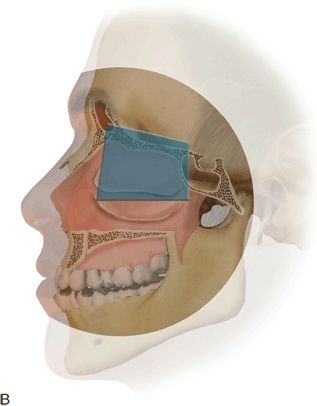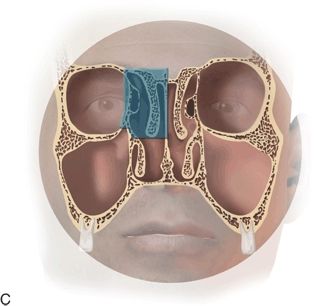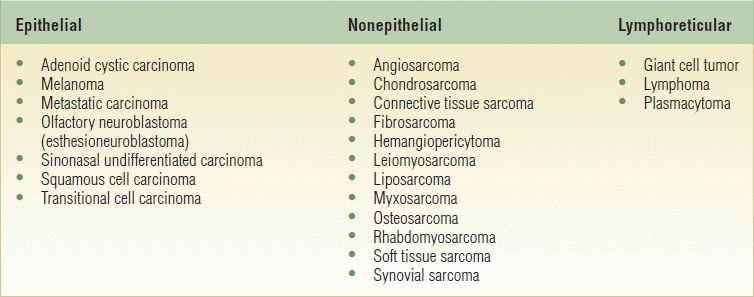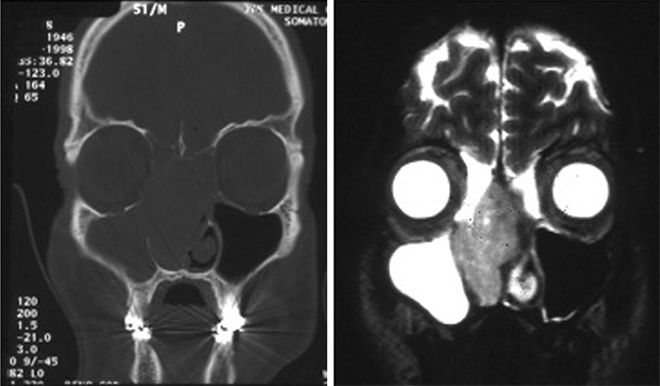

FIGURE 17.1 Coronal (A) and sagittal (B) images illustrating the anatomical limits of a more traditional anterior skull base resection. In select cases, a “hemi” (C) anterior skull base resection may be more appropriate, in order to spare an olfactory bulb.
The anterior skull base is limited laterally, by the medial orbital walls; by the planum or roof of the sphenoid bone, posteriorly; and by the posterior table of the frontal sinus, anteriorly. The midline structures of the anterior skull base include the crista galli and cribriform plates, which are lined intranasally by olfactory neuroepithelium that perforates the cribriform plate, allowing for the transmission of olfactory nerve fibers to the nasal cavity. Lateral to the cribriform plate lies the roof of the ethmoid sinus or fovea ethmoidalis.
Depending on the stage and location of the neoplasm, resection of the anterior skull base may be required to obtain negative superior margins in the surgical management of many sinonasal malignancies (Tables 17.1 and 17.2). However, it is not necessarily the pathology but rather the extent of disease that determines the appropriateness for a purely endoscopic approach versus a craniofacial resection.
Table 17.1 Common Sinonasal Malignancies

Table 17.2 Common Sinonasal Cancer Staging Systems

When confined to the nose, the most common early symptoms are unilateral nasal obstruction and/or epistaxis. These symptoms are nonspecific and usually confused with chronic rhinosinusitis. One must exercise a high index of suspicion in these patients. Depending on the type of pathology and/or the aggressiveness of the neoplasm, additional orbital or neurologic symptoms may ensue. These include proptosis, facial swelling, cranial neuropathy, ophthalmoplegia, visual loss, and/or mental status changes.
PHYSICAL EXAMINATION
Nasal endoscopy, and a complete examination of the head and neck, including cranial nerve assessment, should be performed on all patients. Physical examination may reveal proptosis; extraocular muscle impairment; mass effect of the cheek, gingiva, or gingivobuccal sulcus (e.g., ill-fitting dentures); and/or loose dentition. Numbness of the skin of the cheek or upper lip, or hypesthesia of the infraorbital (V2) branch of the maxillary nerve, strongly suggests malignant invasion of the nerves. Transnasal endoscopic biopsy of the lesion is commonly performed in the office under topical or local anesthesia, when possible. Alternatively, the sampling can be performed in the more controlled environment of an operating room when a deep biopsy is required, when the lesion is difficult to access due to its location (i.e., dependent sinus or skull base), or if profuse bleeding is anticipated.
INDICATIONS
Most benign and malignant neoplasms originating in the nose and paranasal sinuses, which are determined to be free of extensive orbital, intracranial, lateral maxillary, or palatal invasion, may be considered candidates for endoscopic anterior skull base resection as a stand-alone procedure. A combined external/endoscopic approach is otherwise indicated, during the same setting, or staged for a later date. Therefore, patients should be appropriately counseled and provided informed consent.
CONTRAINDICATIONS
Not all lesions are amenable to this technique, due to the extent of supraorbital, orbital, lateral maxillary, or palatal involvement. In such cases, the endoscopic-assisted external approach or more traditional craniofacial resection still affords many of the benefits of a purely endoscopic resection. Tumors in these locations may necessitate an orbital exenteration, a palatectomy, and/or a radical maxillectomy, respectively.
PREOPERATIVE PLANNING
Computed tomography (CT) scan and magnetic resonance imaging (MRI) are considered complementary to each other for the evaluation of neoplastic disease of the paranasal sinuses and adjacent skull base and orbit (Fig. 17.2). CT scan is superior for the evaluation of the bony architecture, assessing for bony erosion or remodeling in critical areas of the skull base and orbit. The use of contrast also reveals tumor vascularity and its relationship to the carotid artery. Disadvantages of CT include its inability to differentiate tumor borders from the surrounding soft tissue and exposure to ionizing radiation. MRI is the best modality for defining soft tissue detail. It can differentiate adjacent tumor from soft tissue (e.g., gadolinium enhances tumor diffusely to an intermediate degree, whereas inflamed mucosa enhances more intensely in a peripheral fashion), differentiate tumor from secretions in an opacified sinus, demonstrate perineural spread (especially adenoid cystic carcinoma), and demonstrate invasion of the dura, orbit, or brain parenchyma. Additional testing, to evaluate or embolize vascular structures (i.e., MRA or angiography), or to evaluate for metastatic disease (i.e., PET/CT), may be necessary in select cases.

FIGURE 17.2 CT and MRI of an esthesioneuroblastoma. Obstructive changes are denoted by the high signal intensity in the maxillary sinus and frontal infundibular area, relative to the low signal intensity of the intranasal and ethmoidal tumor displacing the septum to the left.
Intrathecal fluorescein is not routinely used for elective skull base resections but may be instilled prior to taking the patient back to the operating room to assist the surgeon with skull base reconstruction. The absence of fluorescein along the margins of the reconstructed dural defect denotes absence of cerebrospinal fluid (CSF) leak. Also, intraoperative computer-assisted navigation is not used routinely for anterior skull base resections. However, it may be useful when resection margins are extended posteriorly around the carotid artery and adjacent neurovascular structures. If used, the patient would have placement of fiducials preoperatively and registration performed once the patient is intubated, prior to prepping.
SURGICAL TECHNIQUE (VIDEO 17.1)
Intraoperative Patient Positioning and Prepping
The patient is placed in the supine position on the operating table. Following intubation, the endotracheal tube is secured to the left side of the oral cavity. As with all endonasal procedures, a right-handed surgeon typically stands on the right side of the patient’s head. When a four-handed technique is required, typically during the anterior skull base resection portion of the procedure, the assistant stands to the left of the operating surgeon. Both have simultaneous visualization of the video monitor(s). Ointment is placed in each eye, and each eyelid is secured in the closed position with a transparent dressing, in order to detect the presence of an expanding orbital hematoma. Oxymetazoline-soaked, one-half-by-three-inch, neurosurgical Cottonoids are placed in both nasal cavities. The head of the bed is then rotated 180 degrees. Placing the bed in reverse Trendelenburg helps to decrease venous congestion and intracranial pressure throughout the procedure, if necessary. The patient is prepped with Betadine paint and draped in a sterile fashion, including the nose and both eyes in the surgical field.
After removal of the oxymetazoline-soaked Cottonoids, a 30-degree rigid nasal endoscope is used for visualization and exchanged for a 70-degree rigid nasal endoscope when needed during the course of the procedure. A 70-degree endoscope is useful when inspecting the nasoseptal angle and anterolateral frontal and maxillary sinus margins. One percent lidocaine with 1:100,000 epinephrine is used to inject the septal mucosa, the attachment of the middle turbinate, and the area adjacent to the sphenopalatine foramen when exposure permits. However, depending on the size and extent of the lesion, endoscopic debulking of intranasal tumor may first be required.
Intranasal Tumor Debulking and Determination of the Tumor Epicenter
The surgery begins on the ipsilateral side of the tumor. A microdebrider is used to resect the intranasal portion of the mass, taking care to identify and preserve the point(s) of mucosal attachment and the tumor’s “epicenter.” Although noncutting forceps can be used as an alternative, the microdebrider system has the added benefit of specimen collection into a filtration sock placed on the suction apparatus. Once the mass is adequately debulked, the contents can then be sent for confirmatory pathologic evaluation. The sock is changed as often as needed and labeled appropriately, based on anatomical site. It is not uncommon for the middle and superior turbinates to be involved in the disease process and therefore are removed during debulking. Even if the structure is grossly uninvolved, turbinate resection is performed in order to improve visualization of the anterior skull base. However, it is still sent as a separate specimen for permanent sections.
Tumor Mapping and Clearance of Sinonasal Margins
Stay updated, free articles. Join our Telegram channel

Full access? Get Clinical Tree


